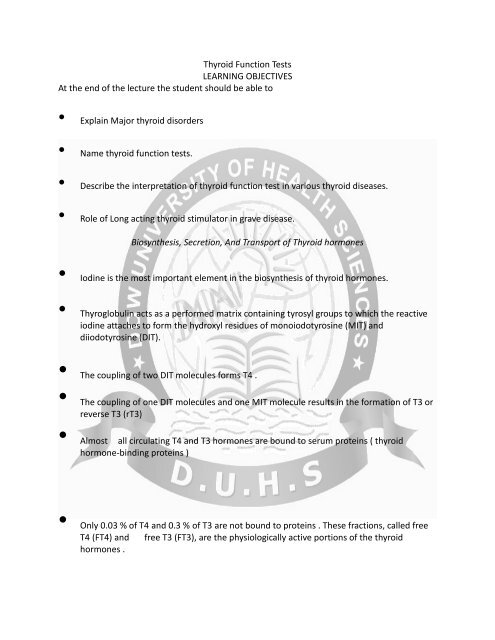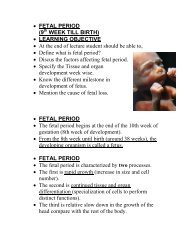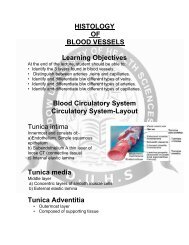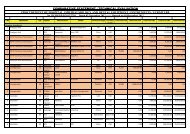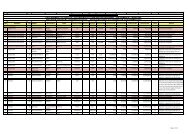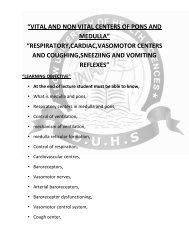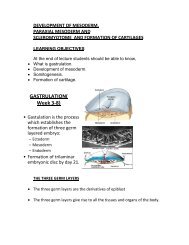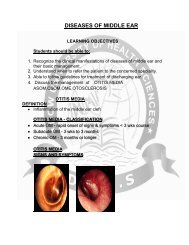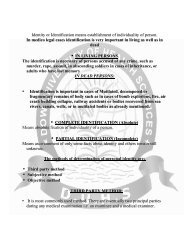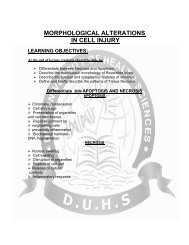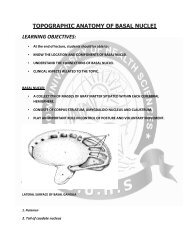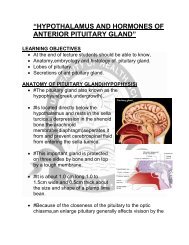Thyroid Function Tests TUTORIAL
Thyroid Function Tests TUTORIAL
Thyroid Function Tests TUTORIAL
Create successful ePaper yourself
Turn your PDF publications into a flip-book with our unique Google optimized e-Paper software.
<strong>Thyroid</strong> <strong>Function</strong> <strong>Tests</strong><br />
LEARNING OBJECTIVES<br />
At the end of the lecture the student should be able to<br />
• Explain Major thyroid disorders<br />
• Name thyroid function tests.<br />
• Describe the interpretation of thyroid function test in various thyroid diseases.<br />
• Role of Long acting thyroid stimulator in grave disease.<br />
Biosynthesis, Secretion, And Transport of <strong>Thyroid</strong> hormones<br />
• Iodine is the most important element in the biosynthesis of thyroid hormones.<br />
• Thyroglobulin acts as a performed matrix containing tyrosyl groups to which the reactive<br />
iodine attaches to form the hydroxyl residues of monoiodotyrosine (MIT) and<br />
diiodotyrosine (DIT).<br />
• The coupling of two DIT molecules forms T4 .<br />
• The coupling of one DIT molecules and one MIT molecule results in the formation of T3 or<br />
reverse T3 (rT3)<br />
• Almost all circulating T4 and T3 hormones are bound to serum proteins ( thyroid<br />
hormone-binding proteins )<br />
• Only 0.03 % of T4 and 0.3 % of T3 are not bound to proteins . These fractions, called free<br />
T4 (FT4) and free T3 (FT3), are the physiologically active portions of the thyroid<br />
hormones .
• T3 is the most biologically active thyroid hormone and is three to four times more potent<br />
than T4. T3 is more active because it is not as tightly bound to the serum proteins as is T4,<br />
and has a greater affinity to target tissue receptors<br />
Actions of thyroid hormone<br />
• Regulation of carbohydrate, lipid, and protein metabolism .<br />
• Central nervous system activity and brain development<br />
• Cardiovascular stimulation<br />
• Bone and tissue growth and development<br />
• Gastrointestinal regulation<br />
• Sexual maturation<br />
<strong>Thyroid</strong> function tests<br />
Specimen collection :<br />
• Specimens are routinely collected in a clot tube, although anticoagulants can be used .<br />
• Specimens free of lipemia or hemolysis are preferred .<br />
The tests used to investigate thyroid function can be grouped into:<br />
• <strong>Tests</strong> that establish whether there is thyroid dysfunction ( TSH,T4 and T3 measurements)<br />
• <strong>Tests</strong> to know the cause of thyroid dysfunction<br />
(thyroid auto-antibody and serum thyroglobulin measurements, thyroid enzyme activities,<br />
biopsy of the thyroid, ultrasound and isotopic thyroid scanning )<br />
TSH :<br />
- The single most sensitive, specific and reliable test of thyroid status .
- In primary hypothyroidism, [TSH] is increased.<br />
- In primary hyperthyroidism, [TSH] is decrease or undetectable<br />
Total T4 and Total T3 :<br />
- More than 99% of T4 and T3 circulate in plasma bound to protein<br />
- Both [total T4] and [total T3] change if [TBG] alters, e.g. in pregnancy<br />
Free T4 and Free T3<br />
Free thyroid hormone concentrations are independent of changes in<br />
the concentration of thyroid-hormone binding proteins → more<br />
reliable for diagnosis of<br />
thyroid dysfunction<br />
Signs and symptoms provide the best indication to request thyroid tests<br />
Interpreting results of thyroid function tests<br />
Primary hyperthyroidism<br />
- Plasma [TSH] : ↓ due to feedback inhibition on the pituitary<br />
- Plasma free and total T4 and T3 concentrations : ↑<br />
In a very small percentage of hyperthyroid patients, plasma [total T4] and [freeT4]<br />
are both normal, whereas both plasma [total T3] and [freeT3] are<br />
increased ; this condition is known as<br />
T3 hyperthyroidism or T3 thyrotoxicosis .<br />
Primary hypothyroidism :<br />
Plasma [TSH] : ↑<br />
Plasma [free T4] and [total T4] : ↓<br />
Plasma free T3 and total T3 measurements are of no value here, since normal concentrations<br />
are often observed .<br />
Sub clinical primary thyroid disease<br />
Plasma [TSH] : abnormal<br />
<strong>Thyroid</strong> hormone levels : normal<br />
[TSH] : low → sub clinical hyperthyroidism<br />
[TSH] : elevated → sub clinical hypothyroidism<br />
Before the diagnosis of sub clinical thyroid disease can be made, causes of an abnormal plasma
[TSH] other than thyroid disease must be excluded<br />
eg : - pregnancy<br />
- drug treatment<br />
Secondary thyroid disorders<br />
• Central (pituitary) hypothyroidism :<br />
[TSH] & thyroid hormone levels → low<br />
• Hyperthyroidism due to a TSH-secreting tumor<br />
very rarely<br />
Plasma TSH is widely used to screen for congenital hypothyroidism in the neonate<br />
( the incidence about one in 4000 live births)<br />
Thyroglobulin<br />
Levels are increased in all types of thyrotoxicosis, except thyrotoxicosis factita caused<br />
by self-administration of thyroid hormone.<br />
The main role for thyroglobulin is in the follow-up of thyroid cancer patients. After<br />
total thyroidectomy and radioablation, thyroglobulin levels should be undetectable;<br />
measurable levels (>1 to 2ng/mL) suggest incomplete ablation or recurrent cancer.<br />
<strong>Thyroid</strong> autoantibodies<br />
The key reason for the measurement of these antibodies is almost entirely for the<br />
management of those with abnormal thyroid function.<br />
Autoimmune thyroid disease is detected most easily by measuring circulating antibodies<br />
against thyroid peroxidase and thyroglobulin (<strong>Thyroid</strong> peroxidase antibodies are also<br />
known as anti-TPO or antimicrosomal antibodies).<br />
In subclinical disease, the presence of thyroid antibodies increases the long-term risk of<br />
progression to clinically significant thyroid disease about two-fold. Almost all patients<br />
with autoimmune hypothyroidism and up to 80% of those with Graves’ disease have TPO<br />
antibodies, usually at high levels, although about 5 to 15% of euthyroid women and up to<br />
2% of euthyroid men will also have thyroid antibodies.<br />
<strong>Thyroid</strong> stimulating antibody –<br />
• (Previously called long-acting thyroid stimulating antibodies or LATS) has a role in<br />
the diagnosis of Graves disease where other test results are ambiguous.
• It may also be useful in pregnant women with Graves disease, to determine the<br />
likelihood of fetal thyrotoxicosis.<br />
References<br />
• Topliss DJ, Eastman CJ. Diagnosis and management of hyperthyroidism and<br />
hypothyroidism. MJA 2004;180:186-93.<br />
• White GH, Walmsley RN. Can the initial clinical assessment of thyroid function<br />
be improved? Lancet 1978;2:933-5.<br />
• Weetman AP. Hypothyroidism: screening and subclinical disease. BMJ<br />
1997;314:1175.<br />
• Helfand M, Redfern C. Screening for <strong>Thyroid</strong> Disease. Ann Intern Med<br />
1998;129:144-58<br />
• Stockigt JR. Case finding and screening strategies for thyroid dysfunction.<br />
Clin Chim Acta 2002; 315: 111-124.<br />
• Helfland M, Crapo LM. Screening for thyroid disease. Ann Int Med 1990;<br />
112:840-9.<br />
• Viera, Anthony J. <strong>Thyroid</strong> <strong>Function</strong> Testing in Outpatients: Are Both Sensitive<br />
Thyrotropin (sTSH) and Free Thyroxine (FT4) Necessary? Fam Med<br />
2003;35:408-10<br />
• Waise A, Belchetz PE. Unsuspected central hypothyroidism. BMJ<br />
2000;321:1275-7.<br />
• Cooper DS. Subclinical Hypothyroidism. N Engl J Med 2001;345:260-5.<br />
• Alexander EK et al. Timing and Magnitude of Increases in Levothyroxine<br />
Requirements during Pregnancy in Women with Hypothyroidism. N Eng J Med<br />
2004;351:241-9.<br />
• Demers LM, Spencer CA. The National Academy of Clinical Biochemistry<br />
Laboratory Medicine Practice Guidelines. Laboratory support for the<br />
diagnosis and monitoring of thyroid disease. Washington (DC): National<br />
Academy of Clinical Biochemistry (NACB); 2002.<br />
(http://www.nacb.org/lmpg/thyroid_lmpg_pub.stm) accessed 24 September<br />
2005.<br />
• Gill M. A handbook for the Interpretation of Laboratory <strong>Tests</strong>. Diagnostic<br />
Medlab, Auckland, August 2000.<br />
THANKS


